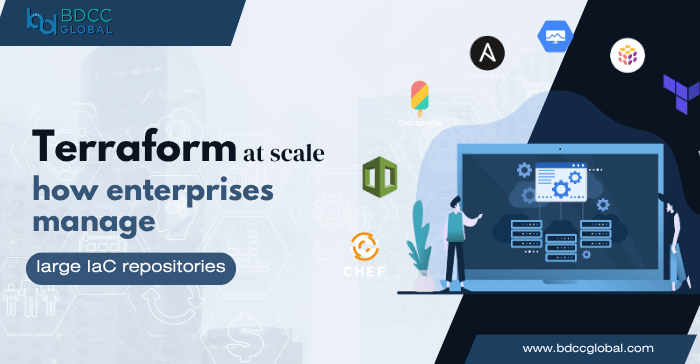
Infrastructure as code (IaC) has become an essential part of enterprise IT. What started as a developer-friendly way to manage infrastructure has now evolved into a strategic discipline. As organizations grow, they face challenges related to infrastructure complexity, team coordination, compliance requirements and governance. In these environments, managing Terraform at scale becomes critical.
This article takes a closer look at how enterprises handle large-scale infrastructure automation using Terraform. It covers the repository structures they use, how they manage governance, and which practices help them stay secure and efficient as they scale.
What challenges arise when scaling Terraform?
Scaling Terraform in an enterprise setting brings a unique set of challenges that go far beyond writing reusable modules or automating simple deployments. As the number of teams and resources grows, coordination becomes harder and risks increase.
Module sprawl and duplication
Without a centralized module registry or design standards, duplication becomes common. This leads to inconsistent patterns and increases the difficulty of maintaining code over time. Explore our guide on Terraform module best practices for infrastructure automation to create scalable and reusable modules across teams.
State management complexity
Terraform stores the infrastructure state in a state file. At scale, managing these state files becomes a significant challenge. Enterprises must use remote backends with locking mechanisms and version control to prevent accidental overwrites or conflicts during simultaneous updates.
Collaboration and access control
When multiple teams manage shared infrastructure, collaboration becomes a critical issue. Enterprises must enforce role-based access controls, adopt branching strategies and ensure that code changes are reviewed before being applied.
Performance issues during plan and apply
As Terraform configurations grow in size and complexity, the time it takes to run plan and apply increases. To improve performance, teams often split their configurations, reduce interdependencies and optimize execution workflows.
How should enterprise’s structure Terraform repositories?
A well-structured repository is foundational to managing Terraform at scale. Enterprises typically adopt one of three structures: mono-repository, multi-repository or a hybrid model. Each has its advantages depending on organizational size, team distribution and operational goals.
Mono-repository approach
A mono-repo consolidates all Terraform configurations for the organization in a single repository. This includes infrastructure definitions across teams, applications and environments. It is best suited for organizations where teams work closely together and follow centralized governance policies.
Benefits of the mono-repo model:
- Easier to apply organization-wide standards
- Centralized module reuse
- Simplified onboarding for new team members
Challenges with mono-repo:
- Slower CI/CD pipelines due to larger codebase
- Increased chance of merge conflicts
- More complex coordination among teams
Multi-repository approach
In this structure, each team or application maintains its own repository. This allows teams to work independently and tailor their workflows to specific needs. It’s a preferred choice in large or decentralized organizations with multiple independent units.
Benefits of the multi-repo model:
- Faster CI/CD pipelines due to isolated codebases
- Clear ownership and access control
- Flexibility to adapt workflows per team
Challenges with multi-repo:
- Risk of version drift between shared modules
- Difficult to enforce global standards
- Higher maintenance overhead
Hybrid repository approach
Many enterprises adopt a hybrid structure to balance standardization with flexibility. Shared modules and policies are placed in a central repository. Individual teams maintain separate repositories for their specific infrastructure. This allows reuse without sacrificing autonomy.
What practices help manage Terraform at scale?
When enterprises scale their use of Terraform, simply having the right structure isn’t enough. They also need best practices for automation, security, consistency and collaboration.
Use policy as code to enforce standards
Governance in Terraform should be enforced through policy as code. Tools like Sentinel, Open Policy Agent (OPA) and Conftest let teams codify security, compliance and operational rules. These policies can be integrated into CI/CD pipelines, ensuring every change follows approved guidelines.
Manage remote state and workspaces carefully
For environment isolation, Terraform workspaces help separate resources like development, staging and production. Enterprises should store their state files in secure backends like AWS S3, Azure Blob Storage or Terraform Cloud, using features like versioning and locking to avoid conflicts.
Automate using robust CI/CD pipelines
Terraform benefits greatly from CI/CD automation. Enterprises should build pipelines that run terraform fmt, validate configurations, generate plans and apply changes only after review. Tools like GitHub Actions, GitLab CI, Jenkins and CircleCI offer robust integrations for these workflows. Setting up Terraform CI/CD pipelines can greatly streamline change delivery; especially in complex setups like multi-region deployment.
Implement drift detection
Over time, manual changes in cloud consoles or third-party tools can create configuration drift. To stay aligned with source-controlled infrastructure, teams should run regular terraform plan checks or use drift detection tools that alert when actual infrastructure differs from the declared configuration.
How can organizations ensure IaC governance?
Good IaC governance ensures that teams stay productive while still meeting compliance and security goals. At scale, this requires more than just tools—it demands processes and policies.
Rely on version control and peer reviews
Every Terraform configuration should live in a version-controlled repository. Enterprises should require peer reviews before merging code. This ensures changes are discussed, validated and tracked.
Use tagging for cost attribution and traceability
Tagging cloud resources with information like team name, environment and purpose helps with cost attribution and resource tracking. Enterprises should enforce tagging standards as part of their Terraform modules or policies.
Secure secrets with external managers
Secrets like API keys, credentials and tokens should never be hardcoded into Terraform files. Instead, enterprises should integrate tools like Vault, AWS Secrets Manager or Azure Key Vault to manage secrets securely and inject them into workflows when needed. Avoid storing sensitive information like secrets directly in Terraform files. Tools like Vault or AWS Secrets Manager should be used in line with security best practices.
How do large enterprises handle module versioning?
Shared modules are the foundation of reusable and consistent infrastructure. But without proper versioning, updates to modules can break existing environments.
Best practices for module versioning:
- Use semantic versioning (e.g. v1.2.0) to label changes
- Pin specific versions in the module source blocks
- Store modules in private registries or versioned repositories
This allows teams to upgrade at their own pace while avoiding unexpected breaking changes.
What tools help with enterprise Terraform management?
Several tools are designed to support Terraform in complex enterprise environments. These tools add layers of automation, collaboration and policy control.
Key tools to consider:
- Terraform Cloud / Enterprise: Adds features like remote state storage, access control, audit logs and workspace management.
- Terragrunt: A thin wrapper that simplifies environment management and helps enforce DRY principles.
- Atlantis: Enables Terraform execution via pull requests for a GitOps workflow.
- Spacelift / env0: Offer advanced policy-as-code engines, cost estimation and integrated Terraform workflows.
These platforms improve team collaboration while ensuring that infrastructure remains secure and auditable.
How can enterprises scale Terraform without losing control?
Scaling Terraform across teams and environments takes more than just good code. It requires organizational effort and cultural alignment.
Recommendations for long-term success:
- Provide internal templates and scaffolding tools to standardize new projects.
- Maintain onboarding guides and internal documentation.
- Assign ownership to modules and environments for accountability.
- Regularly audit Terraform usage and refactor modules when needed.
Successful organizations treat Terraform as a core product within their infrastructure. They invest in its quality, assign ownership and continuously improve processes around it.
Conclusion: managing Terraform at scale with strategy and discipline
As organizations grow, managing Terraform services at scale becomes a critical component of their cloud infrastructure strategy. By choosing the right repository structure, automating processes, enforcing governance and using the right tools, enterprises can gain full control over their infrastructure.
Terraform at scale enables faster delivery, better compliance and improved stability. Enterprises that take a thoughtful, well-structured approach can turn their infrastructure codebase into a competitive advantage.

